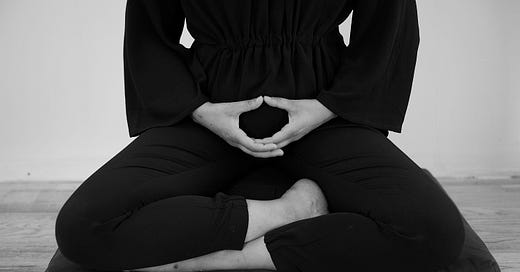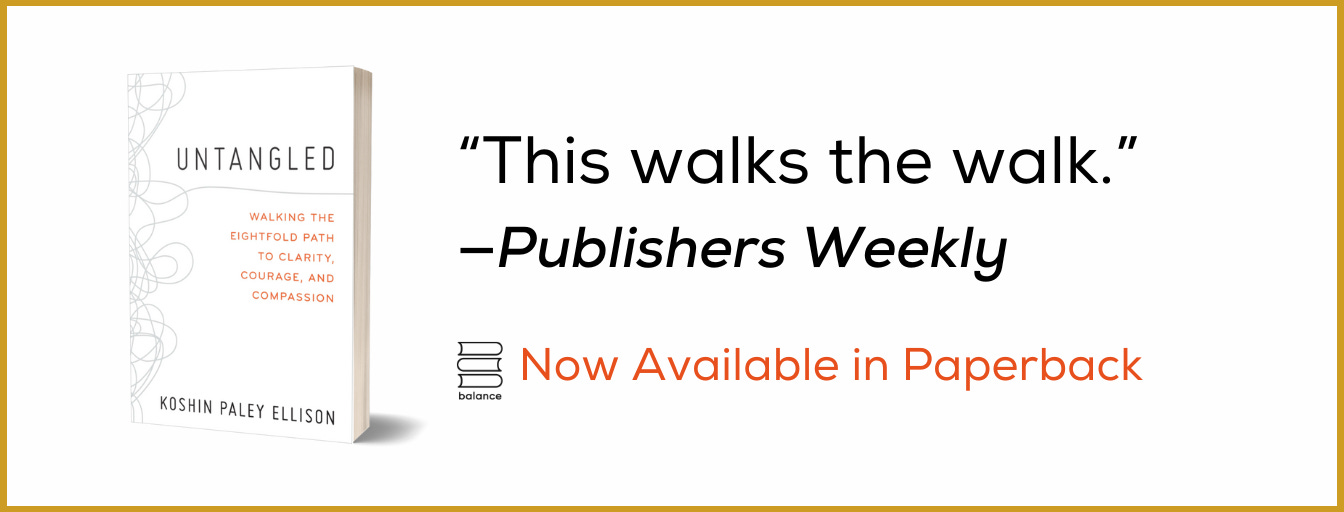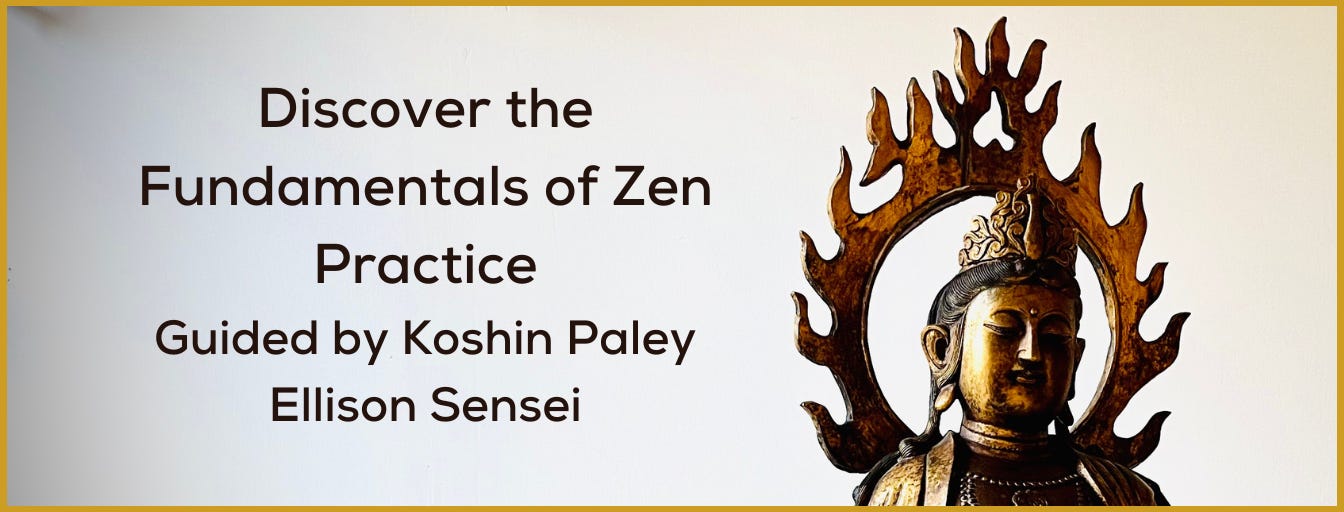Good for Nothing: A Guide to Zen Meditation
The path is not always pleasurable, sometimes it’s excruciating, and yet!
When the Buddha taught meditation, he would often teach, “When a person, mindful, ardent, and alert, having put aside greed and distress with regard to the world, sits down to meditate…”
These are the attitudes that make meditation possible: mindfulness, ardency, alertness, and putting aside greed and distress with regard to the world. Attaining and comparing are not the frameworks we meditate within.
That means we don’t judge our value as a person based on how our meditation goes. We leave behind the strategies of the ego and the categories of worldly success—even if it’s the so-called spiritual world we’re talking about. We leave behind judging the body in terms of the world. We put aside thoughts and feelings like “Would the world think this face is attractive or not? Am I aging well?”
We can do the same with feelings or thoughts that come up when we meditate. We don’t need to view them in terms of what they supposedly say about our worth as people, or what we imagine other people would say about them, or what we think they say about us. What would that be like to practice with?!
Kodo Sawaki Roshi, one of the most important Soto Zen teachers in twentieth-century Japan, once said, in his typically provocative style, that when we do zazen (seated meditation) we practice going back to our mother’s womb. He also said zazen is “good for nothing.” What he meant is that when we practice zazen, we put down all the losing and gaining, all the striving and struggle, all the trying to get or be anything.
That’s one of the reasons why zazen is so important. It gives us rest. It lets us experience ourselves apart from all that. Over time it also cultivates a ground where there are many more possibilities than those circumscribed by our normal greed, distress, and clinging.
A student of mine recently told me that he had begun meditating, and all of these memories that he regretted, all of this pain over things he had done or said, came up. “I must be doing it wrong,” he said to me.
But for me, this is a crucial part of the process of gathering the self together.
In meditation, difficulty and discomfort is guaranteed to arise. It is going to be hard. It is going to be difficult, and to me, hitting that difficulty means it’s going well. This is when we really are getting into it!
It is important to know that sometimes this is going to be difficult, and it might be painful, and there may be a lot of grief. Yet there is this powerful healing that can take place when we stay the course.
We need to allow all parts of ourselves to come up, to be gathered and to be present and to dissolve in the light of awareness without feeding our greed and distress with regard to the world. We can allow ourselves to just be what we are, and we view ourselves in terms of zazen, which means we let thoughts and feelings arise and pass away without resistance or grasping. What a relief.
Posture is a place of practice.
Posture is important for Zen meditation, whether it’s done in a chair, lying down, on a cushion, or on a bench. As Dogen teaches, what is key is how you hold all of it with what he called roshin, or the grandmotherly mind. Some people can get intense and use posture like a weapon—which might be aimed at themselves or others. So before we even get into posture, let’s remember that attitude, because the attitude in which we practice is so important.
Zen is interested in how we physically sit in meditation. The sitting is not just about how you physically sit; it is also about how you sit with fear and the ten thousand joys and the ten thousand sorrows. How do you learn, like the Buddha under the tree, to sit and not be blown away by the winds of life?
To begin again and again…find a comfortable place to sit. Having a designated place in your home is helpful. Sometimes you don’t have that space and have to improvise—sometimes you’re in a hotel room or you live in a small space, and you have to get creative. The beauty of this practice is that you can do it anywhere. Second, find a way to sit upright and comfortably. If you’re sitting in a chair, sit upright under your own power if you can, unless you need back support, in which case sit against the back of the chair. Plant your feet on the ground. If you don’t need the back support, sit at the front of the chair, so that your hips are tilted a little bit forward, which is energizing. You want to create a strong base. It’s also helpful, whatever your position, to rock a little bit back and forth, feeling your round sit bones and finding your center. Rotate your hips forward so that your lower spine curves a little bit.
It can be helpful to stretch your arms behind you. It’s also helpful to open your shoulders by rolling them backward. We tend to hold a lot of tension in our shoulders.
Then put your hands in the hand position, or mudra, to use the fancy term, where your left hand lies in your right palm, and your thumbs lightly touch. Put your hands in your lap, close to your body, so your thumbs are approximately at a space two inches below your belly button. (Having your thumbs near that area, you’re creating a circle. You don’t want to hold your hands too loose or too tight. If you allow your mind to wander too much, your hands will collapse.)
Posture is a wonderful way to hold your heart and mind.
Place your hands and then notice your breath in your hara, that place two inches below your belly button. And see, before you adjust further, what it is like to simply be with your breath and feel your lower belly expanding and contracting with your breath. Notice what happens with your mind as you do that.
Next, come back up through your spine. Imagine that the crown of your head is attached to the sky, so there’s an uprightness there. Remember, though, that uprightness looks different for different bodies. You want to find a comfortable uprightness for you.
Slightly tuck in your chin. And here’s the tricky part: Lower your eyes to a forty-five-degree angle without tilting your head. Learn to keep your head upright while gazing down. In many forms of meditation, people close their eyes. In Zen meditation, we keep our eyes open and gaze down at a forty-five-degree angle. Why do we do this? Well, the position we place our hands in is one often found on Buddha statues, and you may have noticed that Buddha statues all gaze downward in this same way. Taking this hand position and lowering our gaze is a way of saying that when we practice zazen, we embody Buddha.
Let’s practice together.
As you begin to sit, notice if you have put all the pieces of the posture together.
Grounded, soft, upright, open.
Do you have a strong, grounded base? Can you feel your sit bones, the lengthening of your spine, the opening of your shoulders, the softness in your belly, the connection of your hands, and the uprightness of your head gazing down?
Now notice your breath in your hara again, and you feel the need to adjust anything. When you feel settled, it’s time to pay attention to the breath at the hara. The foundational practice is counting the breath. On the inhalation, count ‘one,’ and on the exhalation, count ‘two,’ and so on. In theory, you go to ten, and then start at one again, like a circle. But the key part is that each time your mind wanders and you think, What’s for lunch? What’s for dinner? Why didn’t they email me? then you come back to counting at one. I imagine it like going a little bit off-screen—you go too much this way or that way. You start following a thought, or going into some fantasy about something—then you just come back.
So if you count one and then you imagine, How am I going to deal with that difficult person?, you come back to one. Whatever it is, whatever distraction you’re experiencing, no problem. Just come back to one. Bring yourself back gently and tenderly.
You may be sitting or standing or lying down or walking. Find your breath in your body. Where is it? In your neck? Shoulders? Chest? Solar plexus? Hara?
Place your hands for a moment two inches below your belly button and feel the breath moving your hands. Allow the breath to move your hands for a few breaths. Pause and experience.
What do you notice about your quality of mind?
Courageously beginning at one again and again is a place of practice
Let’s have a dialogue.
I’m curious.
How do you cling and grasp at the world? What supports you setting this greed and distress down? Is there anything about yourself that have gathered into your practice that has surprised you? Please share your wisdom and experiences with others in the comments below.
May you find the space to sit, to rest, and to show up for practice each day.
Koshin.












Maybe it's a bit funny so I'll share it. My first take of the picture before the brain figured out it was actually someone meditating…was that of a teddy bear.
I began sitting zazen to be enlightened. I wanted to be smarter, more calm, and better adjusted than others. I tried very hard. Once early in my practice, I had an experience of realization of the interdependence of all beings and phenomena, I saw clearly that none of us is separate and I understood all this in a completely new way. I went to my teacher with all this, wanting to be validated as a now enlightened being! I got it now, I reached the Zen master level! I was ready to save all sentient beings!
My teacher looked at me and asked "How's your breathing? How's your posture?"
"My breathing? My posture? I don't know, I've been looking at the fundamental nature of human existence! Zazen helped me break through! I now see what the Heart Sutra is talking about!"
My teacher peered over reading glasses "That isn't important. How's your breathing? How's your posture?"
Oof, I was so mad I just gave up doing zazen for any purpose. I just wanted to complete the sesshin I was in the midst of, then I would find a teacher who cared about my enlightenment. I just began to sit without any purpose other than remaining upright and not drawing any attention from others until the bell rang. This meant I focused on my posture and breathing so I would fit in.
That was 17 years ago, I still sit the same way today.